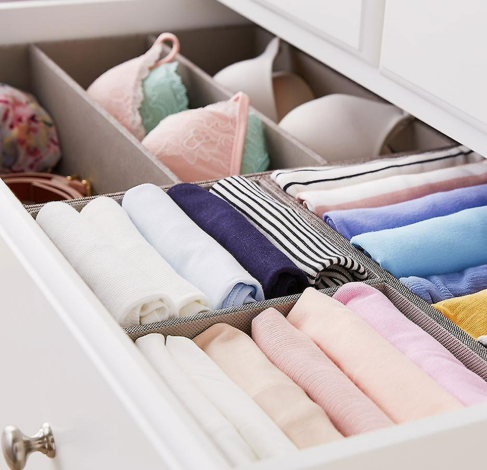
7 Essential Tips for Storing Your Out-of-Season Clothes
Properly storing your off-season clothes ensures they stay in excellent condition and are ready to wear when the weather changes. Whether you’re packing away heavy winter coats or light summer dresses, the right techniques will help prevent damage from moisture, pests, and improper storage.
Here are seven key tips to help you store your seasonal clothes safely and effectively, so they remain fresh and protected.
1. Declutter Your Wardrobe
Before packing away your out-of-season clothing, take the time to declutter your wardrobe. This is the perfect opportunity to assess your clothing and get rid of items that no longer fit, are outdated, or simply don’t suit your style anymore. By removing unnecessary items, you’ll ensure that your wardrobe remains organized and that you only store the pieces you actually wear.
Check for any wear and tear, like loose buttons or broken zippers. If an item is too damaged, consider donating or recycling it rather than storing it away for another season.
2. Clean Clothes Before Storing
Cleaning your clothes before putting them away is crucial for preserving their condition. Sweat, oils, and food residue left on fabrics can attract pests like moths and beetles, which thrive on natural fibers such as wool and silk.
Use a mild, fragrance-free detergent, and opt for a gentle wash cycle to protect your garments. For delicate fabrics such as cashmere or silk, follow the specific care instructions. After washing, air dry your clothes to avoid shrinkage and preserve the fabric. Before storing, also inspect garments for any loose threads or minor damage and make necessary repairs.
3. Choose the Right Storage Containers
The right storage containers can significantly extend the life of your clothes. Transparent plastic bins are an excellent option for seasonal storage. They protect clothes from dust, dirt, and pests while allowing you to easily see what’s inside. These bins are especially great for heavier fabrics like wool.
Make sure to avoid overstuffing the bins, as this can cause the fabric to wrinkle or lose its shape. Label each container by category, such as “winter coats” or “summer dresses,” for easy access when the seasons change.
For a more breathable option, consider cloth garment bags or fabric baskets. Adding cedar blocks to these storage options provides natural pest control and helps prevent damage from moths.
4. Use Natural Moth Repellents
Moths can be a major issue when storing seasonal clothing, especially those made from natural fibers. Traditional mothballs can be toxic and harmful to both humans and pets, so it’s best to use natural alternatives.
Cedar blocks and sachets filled with lavender or rosemary offer a chemical-free solution to keep pests at bay. Place them inside your garment bags or storage bins, but be careful not to let the repellent come into direct contact with your clothes, as it can leave stains due to the oils in the herbs.
5. Find the Ideal Storage Location
The location of your seasonal clothing is just as important as how you store it. Choose a cool, dry, and dark space to avoid exposure to moisture or excessive light, which can cause fabric degradation or mold growth.
Basements, attics, or garages can work, but be mindful of humidity levels. Excess moisture can lead to mildew and musty odors, so check your storage area for any moisture issues. If you’re short on space, under-bed storage bins or empty dresser drawers are great alternatives. Just be sure to avoid overcrowding, as air circulation is key to preventing mold.
6. Be Mindful of Hangers
Hanging clothes can be a space-efficient solution, but not all fabrics are suitable for hanging. Delicate materials like silk or heavy items like wool coats may become misshapen if left on hangers for long periods.
For heavier items, opt for sturdy wooden hangers that provide the necessary support. For more delicate fabrics, such as silk blouses, it’s better to fold them and store them in breathable storage containers. Avoid overfilling your closet to ensure air can circulate properly around your garments.
7. Don’t Overuse Vacuum-Sealing
Vacuum-sealing can be a fantastic space-saver, especially for bulky items like jackets or bedding, but it’s not suitable for all fabrics. Structured garments like blazers or padded coats can lose their shape when compressed, and delicate items like silk or sequined dresses might suffer damage from the friction of being tightly packed.
Instead of vacuum-sealing these items, fold them properly and store them in breathable bags or containers with acid-free tissue paper. Knitwear and linens are more suitable for vacuum-sealing, as they can handle the compression without losing their integrity.
Bonus Tip: Store in a Climate-Controlled Space
If possible, storing your off-season clothes in a climate-controlled environment is the best option. A temperature range of 60-70°F and a humidity level of 50-55% is ideal for preventing mold growth and preserving the quality of your garments. If you’re using spaces like garages or attics, consider investing in a portable air conditioner or dehumidifier to maintain optimal conditions.
By following these storage tips, you can ensure your clothes stay in great shape and are ready to wear when the season changes. Proper storage not only helps protect your clothing but also saves you time and money by extending the lifespan of your favorite garments.






